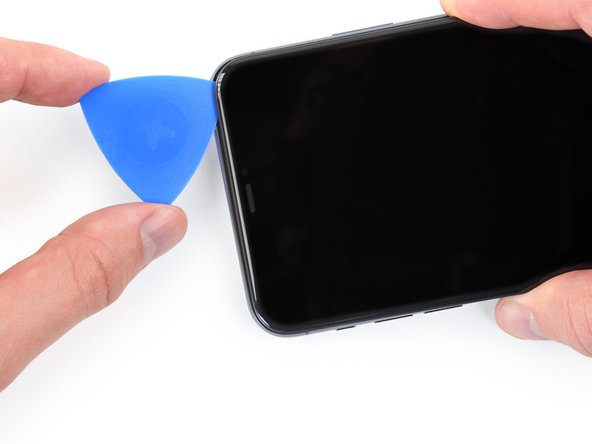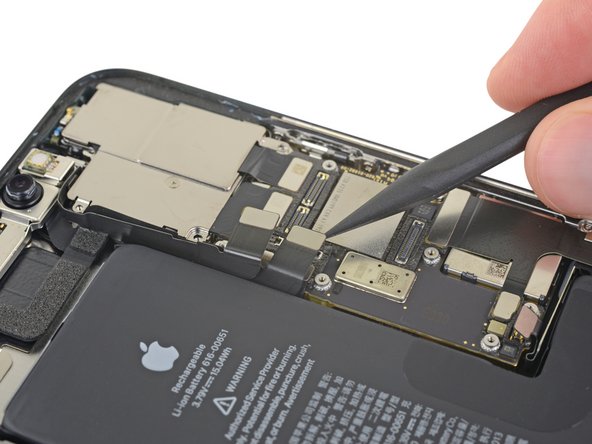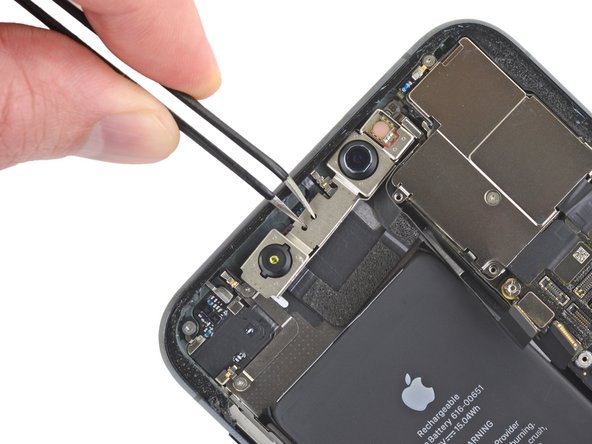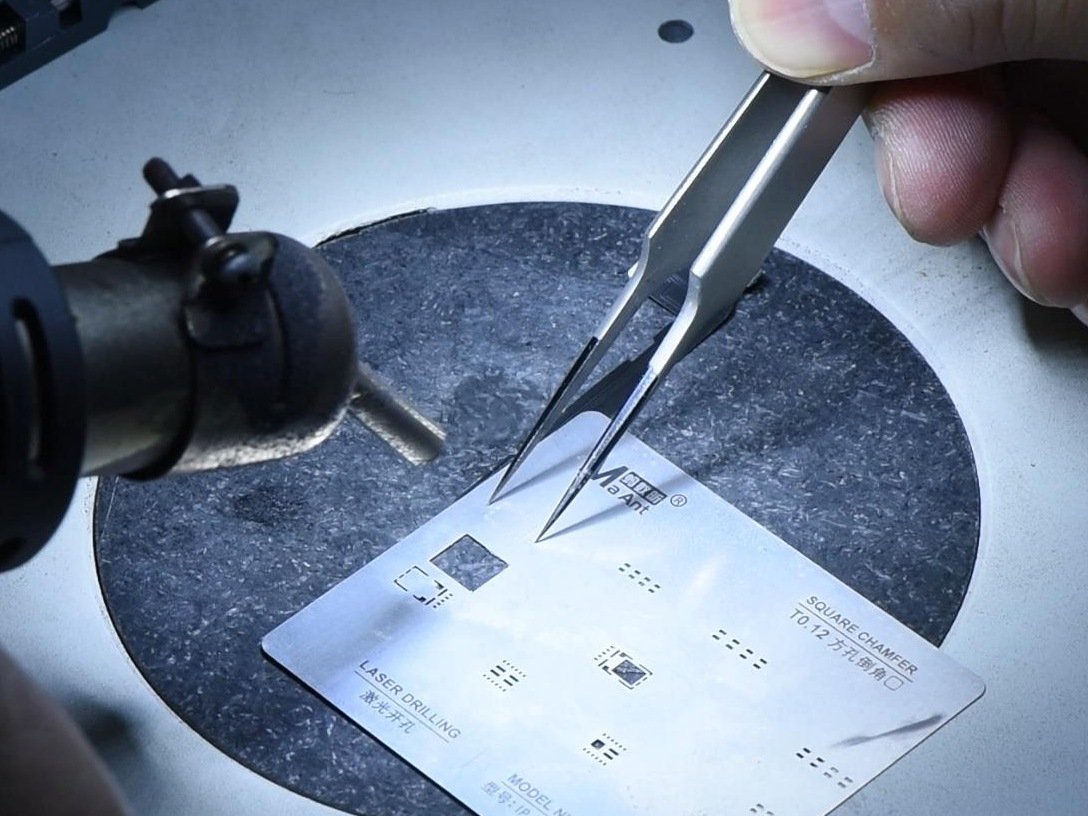iPhone 11 Pro Max Front-Facing Cameras Replacement
Duration: 45 minutes
Steps: 28 Steps
Heads up: Face ID won’t be able to do its magic after this.
Get ready to dive into the world of repair! In this guide, we'll show you how to swap out the front camera assembly (yep, that's your selfie cam!) in your iPhone 11 Pro Max. Just a little heads up: replacing this part means Face ID will take a little vacation and won’t work anymore. But don’t worry! We’ll have your broken selfie cam up and running in no time. If you want Face ID to be all sparkly and functional again, only Apple or an Apple-authorized technician can make that magic happen. If you find yourself in a tough spot, just remember you can always schedule a repair for a helping hand!
Step 1
Heads up! Make sure your iPhone battery is under 25% before starting. If you poke a fully charged lithium-ion battery, it can get fiery—or even explode. Let's keep things cool!
Popping open your iPhone’s display will break its waterproof seals. Make sure you have replacement seals on hand before moving forward, or be extra careful to keep moisture away if you put it back together without swapping the seals.
- First things first: power down your iPhone before cracking it open.
- Unscrew the two pentalobe screws (6.7 mm each) hanging out at the bottom edge of your iPhone.
Step 2
Pushing the pick in too deep can mess with your device’s insides. To keep things cool, mark your pick so you know exactly how far to go.
Want extra style? Mark the other corners with different measurements for more precision.
Or, get creative—tape a coin to the pick about 3 mm from the tip for an instant depth stopper.
- Take a moment to measure 3 mm from the tip and give the opening pick a little love tap with a permanent marker to mark its spot.
Step 3
Pop on those safety glasses to keep your peepers safe from any sneaky glass shards that might decide to jump ship during the repair!
Screen looking like a spider web? Slap some tape over the glass to keep things in one piece and save your fingers from tiny glass surprises.
If your suction cup keeps slipping, get creative—try a dab of superglue to stick it to the screen.
- Cover the iPhone’s screen with overlapping strips of clear packing tape until the entire front is sealed up tight.
- If the suction cup refuses to stick in the next steps, no worries — fold a sturdy piece of tape (like duct tape) into a little handle and use that to gently lift the screen instead.
Step 4
The next three steps walk you through using the Anti-Clamp, a handy tool we created to make opening your device a breeze. If you’re not using the Anti-Clamp, just skip ahead three steps for another way to get the job done.
For full details on how to handle the Anti-Clamp like a pro, check out this guide.
If your iPhone’s surface feels too slick for the Anti-Clamp to grip, no worries—just slap on some tape to give it a better hold.
- Give that blue handle a gentle tug backward to unleash the Anti-Clamp's arms.
- Slide those arms over the left or right edge of your iPhone like a pro.
- Place the suction cups close to the bottom edge of your iPhone—one on the front and one on the back.
- Squeeze the cups together to get a strong grip on the area you want to work on.
Step 5
- Slide that blue handle forward to lock those arms in place—easy does it.
- Spin the handle all the way around clockwise (yep, a full circle) or until you see the cups start to stretch.
- Keep an eye on those suction cups! If they start wandering off, loosen them up a bit and bring those arms back in line.
Step 6
Take it easy and only twist a quarter turn at a time, then chill for a minute before the next go. Let that Anti-Clamp and a bit of patience do their magic for you.
Feel free to bring out the hair dryer, heat gun, or hot plate if you need a little extra warmth! Just remember: too much heat can be a bummer for your display and the internal battery, so go easy on it.
If the Anti-Clamp isn't quite bridging the gap you're looking for, turn up the heat a notch and give that handle a quarter twist!
- Warm up that iOpener and slide it through the arms of the Anti-Clamp like a pro.
- Bend the iOpener so it rests snugly on the bottom edge of your iPhone.
- Patience is key! Wait a full minute to let that adhesive loosen up and create a lovely little opening gap.
- Gently slide an opening pick into the gap between the screen and the plastic bezel—just avoid the screen itself, please!
- Feel free to skip the next three steps. You've got this!
Tools Used
Step 7
Heating up the bottom edge of your iPhone helps loosen the adhesive holding the display in place, making it way easier to pop that screen off. A little heat goes a long way here!
- Grab a hairdryer, heat gun, or your trusty iOpener and warm up the bottom edge of your iPhone for about a minute. This loosens the sticky stuff holding everything together—just enough so you don't have to wrestle with it.
Tools Used
Step 8
- Place your single suction handle on the bottom edge of the phone, steering clear of the curved glass area to get a good grip.
Tools Used
Step 9
The adhesive keeping that display snug as a bug is super strong, so getting that first gap open is no small feat! If you're finding it tough to create some space, don't sweat it—just add a bit more heat and gently wiggle the screen up and down. That should help loosen the adhesive enough for you to slide in your tool. You've got this!
- Give that suction cup a good pull with steady pressure to open up a little gap between the front panel and the rear case.
- Slide an opening pick into that nifty gap you've created.
Step 10
Be careful not to shove your pick in more than 3 mm, or you might poke something you shouldn’t inside!
- Carefully work the opening pick around the bottom left corner and along the left side of the iPhone, cutting through the adhesive that’s keeping the display in place.
Step 11
Heads up! There's a fragile cable running along the right edge of your iPhone. Avoid sliding your pick in there to keep everything safe and sound.
Step 12
Keep your pick shallow—no deeper than 3 mm—to avoid giving those delicate display cables a hard time.
- Slide your pick back in at the bottom edge of the iPhone, then cruise up the right side to keep peeling away that stubborn adhesive.
Step 13
The upper edge of the display is held in place with a combo of glue and clips. Keep that in mind as you tackle this part!
- With a gentle touch, nudge the right edge of the display downward a tad, angling towards the Lightning port like you're giving it a friendly wiggle.
- Slide your trusty pick into the top-right corner of the phone, just like you’re slipping a note under a door!
Step 14
Be careful not to insert your pick more than 3 mm in, or you might accidentally mess with the front panel sensor array. A little goes a long way!
- Gently pull the display down toward the Lightning port until you've created a gap wide enough for your trusty pick.
- Slide that pick over to the top left corner and slice through any leftover adhesive that's clinging to your display.
Step 15
- Give that little nub on the suction cup a gentle tug to pop it off the front panel.
Step 16
Hold up! Before you go full throttle and try to detach the display, remember that there are some delicate ribbon cables still cozying up to the iPhone's logic board. Let’s be gentle here!
- Start by lifting the iPhone's display up from the left side, just like you would open a book's cover. Easy peasy!
- Prop the display up against something sturdy to keep it steady while you dive into the repairs. You've got this!
- When it's time to put everything back together, gently lay the display back in position. Make sure the clips along the top edge are aligned, then press the top edge into place with care before snapping the rest of the display down. If it feels a bit stubborn, give the clips around the edges a quick check to ensure they're not bent. Remember, a little patience goes a long way!
Step 17
As you embark on this repair journey, remember to keep an eye on each screw and return it to its original spot. This will help keep your iPhone safe and sound!
- Unscrew those two 1.3 mm Y000 screws holding the battery cover bracket in place. You've got this!
- While you're in the zone, why not power on your iPhone and give everything a quick test before sealing up the display? Just remember to power it back down all the way before diving back into your repairs.
Step 18
- Carefully take off the bracket to get things moving.
Step 19
Be careful not to mess up the sleek black silicone seal around this and other board connections. These little heroes help keep water and dust at bay, giving your device an extra layer of protection!
- Grab a spudger or a clean fingernail and gently lift the battery connector off its socket on the logic board.
- Once it's loose, give the connector a slight bend away from the logic board. This keeps it from accidentally touching the socket and powering up your phone while you're working on it.
Tools Used
Step 20
- Grab your trusty Y000 driver and get ready to unscrew! Remove those six 1.3 mm screws holding the logic board cover bracket in place. You're doing great, keep it up!
Step 21
- Carefully take off the bracket to keep things moving!
Step 22
- Pop off the OLED panel cable connector with a spudger or your trusty fingernail—gently, like you're opening a secret snack stash.
- When reconnecting, line up the connector and press down one side until you hear a satisfying click, then do the same on the other side. Skip pressing the middle—misaligned pins are no joke and can cause permanent damage.
Tools Used
Step 23
- Gently pry up the front sensor assembly cable connector using a spudger or your fingernail to unplug it.
- Next, carefully disconnect the digitizer cable connector with a spudger or your fingernail.
- If your screen isn't responding to touch after the repair, power down and disconnect the battery, then firmly reconnect this cable until it clicks into place—make sure the socket is clean and free of dust or debris.
Tools Used
Step 24
- Carefully take off the display assembly.
- When putting everything back together, take a moment here if you want to swap out the waterproof adhesive around the edges of the display.
Step 25
- Gently pry up the Face ID dot projector and sensor cables from their logic board sockets using a spudger or your fingernail. Take your time and keep it cool!
Tools Used
Step 26
- With a gentle touch, nudge the Face ID cable connectors away from the logic board. This will reveal the selfie cam connector hiding beneath. No need to rush; we’re taking it nice and easy!
- Now, it's time to disconnect the selfie cam. Just pry its connector straight up with care, and voilà! You've done it!
Step 27
Carefully handle the front camera assembly with your tweezers, and try not to leave any fingerprints on those sensitive sensors! They're shy, after all.
- Gently nudge the front camera assembly a little down and to the left—just enough to slide it out of its cozy spot.
Tools Used
Step 28
- Give your new part a quick comparison with the old one—sometimes there's a leftover sticker or a sneaky component that needs to come along for the ride.
- Time to put everything back together! Just work your way through the steps in reverse.
- Done with the old parts? Toss them responsibly at an R2 or e-Stewards certified recycler.
- If your device is still giving you attitude, try some basic troubleshooting, or you can always schedule a repair for backup.









































































